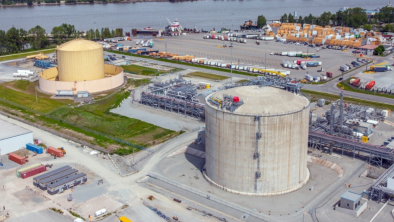The true cost of the Woodfibre LNG plant in Squamish

The Georgia Straight
By Eoin Madden
June 4, 2014
Sometimes it's easy to forget about what climate change will eventually mean for you or your neighbours. But coastal towns like Squamish are acutely exposed to the costs of climate change: a federal government report states that B.C.’s timber losses could range from $500 million to $3 billion, and that flooding protection costs would rise to more than $2,000 per person by 2050.
We’re already seeing the effects of climate change appear in our home insurance policies, with increasing costs for water damage coverage. Rising sea levels will seriously impact low lying areas. And Howe Sound is in the danger zone when it comes to ocean acidification, a phenomenon driven by climate change.
Into this sorry situation steps Woodfibre LNG, with its proposal to construct a new gas liquefaction plant on the site of an old pulp mill in Squamish. Woodfibre is just one of many gas plants proposed for our west coast, and in order to feed these plants, thousands of new gas wells would need to be drilled in northeast B.C. This gas will then be shipped to Asia.
In B.C., nine out of 10 gas wells extract gas using the dangerous method of hydraulic fracturing, or “fracking”. Fracking releases large amounts of methane, a greenhouse gas that has a much greater impact on our climate than any other gas. In short, fracking drives climate change. It is also a massive freshwater user.
The arguments in favour of the Woodfibre project hinge on the expected commercial tax income for the District of Squamish, as well as the much-lauded job creation: 600 construction jobs and 100 permanent jobs, we are told.
What support there is for the project is based on these numbers, and on references to the closure of the pulp mill on the site of which the proposed terminal is to be located. But many Squamish residents recognize the conflict between this proposal and the area’s flourishing outdoor economy.
The population of Squamish has grown by more than 14 percent in the last decade, with an influx of relatively young people drawn by the beautiful surroundings of Howe Sound. A new breed of job creators arrived in that rush: the decision by online mountain bike retailer PinkBike to relocate its head office here is just one example of the type of outdoor-focused employer Squamish has attracted. It is fast becoming renowned as a rock-climbing and mountain biking mecca.
The economic value of maintaining a clean, outdoor-focused image is often undervalued in B.C. A recent SFU study showed that hikers, cyclists, kayakers and other non-motorized recreationists contribute billions to B.C.’s economy every year, and Squamish is perfectly poised to capitalize on this recreation bonanza. Looking at climbing alone, a 2008 report showed $25 million in direct economic impact to Squamish annually, with the potential to grow to $75 million by 2018.
When I’m not working to raise awareness about climate change, I run. I dream of one day being able to complete the Squamish 50, one of North America’s most respected and loved ultra-marathon trail runs. It’s not just the challenge of running 50 kilometres across forest trails and along rocky cliff faces that draws the crowds: the race is just one part of an entire trail running festival which takes place annually. The festival’s organizers rightly state that Squamish is a rare piece of trail paradise.
This August, racers will arrive in town willing to pay good money for food, accommodation, and refreshments. Combined with the ubiquitous mountain bikers, hikers, and climbers who will be heading for other trails that weekend, the event represents a sizeable income-generator. It is with a sinking feeling that I have to ask myself: what happens if Woodfibre LNG is built? How does a huge gas plant on the town’s doorstep affect its reputation as the “Outdoor Recreation Capital of Canada”?
Today’s Squamish is a success story. It has taken advantage of its naturally abundant setting and has proven to us all that it’s possible to create a thriving economy without contributing greatly to climate change. Whether it’s the heavy cost of climate change for everyone, or the potential cost of outdoor enthusiasts turned off by the presence of a huge industrial plant, Woodfibre LNG represents a major step backwards for the new economy of Squamish.
Photo: The view from the top of the Chief, Squamish BC (Johannes Gilger via Flickr).


